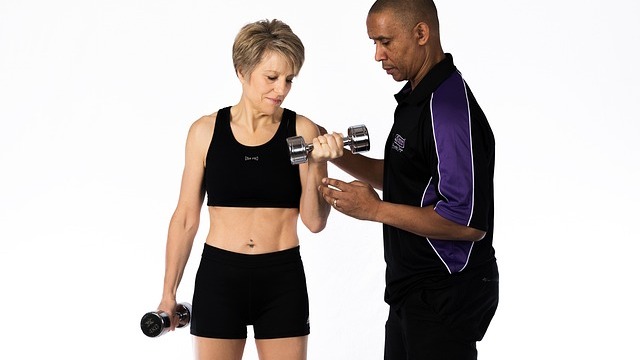
Learn 7 ways strength training can slow down the aging process and help keep you feeling young.
The fountain of youth might not be a magical spring, but it could very well be found in the weight room. As we journey through our 50s, 60s, and beyond, our bodies naturally undergo changes that can impact our quality of life. However, strength training offers a powerful counterforce to these changes, helping us maintain vigor, independence, and vitality for decades. Here's how pumping iron can turn back the clock on aging.
1. Reverses Age-Related Muscle Loss (Sarcopenia)
Beginning in our 30s, we lose approximately 3-5% of our muscle mass per decade unless we actively work to preserve it. This condition, known as sarcopenia, accelerates after age 60 and can lead to weakness, mobility issues, and increased risk of falls.
Strength training directly combats this decline by stimulating muscle protein synthesis, the process through which muscles repair and grow. Studies from the Journal of Applied Physiology demonstrate that adults in their 70s and 80s can increase muscle mass by up to 3-4% in just a few months of resistance training. This isn't just about looking fit—it's about maintaining the fundamental strength needed for everyday activities like carrying groceries, climbing stairs, or playing with grandchildren.
2. Restructures Body Composition
While the scale might not always reflect it, strength training dramatically reshapes your body composition—the ratio of fat to lean tissue. Even if your weight remains stable, lifting weights can reduce body fat percentage while increasing lean muscle mass.
This restructuring has profound implications for metabolic health, as visceral fat (the dangerous kind that surrounds organs) is associated with inflammation, insulin resistance, and cardiovascular disease. By shifting your body composition toward more muscle and less fat, strength training creates a physiologically younger profile, reducing the risk factors associated with age-related diseases.
3. Strengthens Bones and Prevents Osteoporosis
Bone mineral density naturally decreases with age, particularly in postmenopausal women. This can lead to osteopenia, osteoporosis, and heightened fracture risk. Resistance training creates beneficial stress on bones, triggering them to absorb more calcium and grow stronger—a process called bone remodeling.
The Journal of Bone and Mineral Research has published numerous studies showing that regular strength training can increase bone density by 1-3% annually in older adults—effectively reversing years of age-related bone loss. The pulling forces that muscles exert on bones during strength exercises serve as a powerful stimulus for maintaining bone architecture and strength throughout life.
4. Enhances Neurological Function and Brain Health
Perhaps one of the most overlooked benefits of strength training is its impact on our nervous system. Research from the Frontiers in Aging Neuroscience journal indicates that resistance exercise improves neuromuscular connection—the vital communication pathway between brain and muscles.
This neural adaptation explains why strength gains often precede visible muscle growth, as the brain becomes more efficient at recruiting muscle fibers. Additionally, strength training increases brain-derived neurotrophic factor (BDNF), a protein that promotes neuron health and cognitive function. Regular lifters demonstrate better executive function, memory, and processing speed—all cognitive abilities that typically decline with age.
5. Optimizes Hormonal Balance
Hormonal changes significantly impact how we age. Testosterone and growth hormone—both critical for muscle maintenance, bone health, and overall vitality—decline naturally as we age. Strength training provides a powerful stimulus for optimizing hormone production, with research showing that compound lifts like squats and deadlifts can temporarily increase testosterone and growth hormone levels by 15-30%.
For women navigating menopause, strength training helps mitigate the effects of estrogen decline, reducing hot flashes, improving sleep quality, and maintaining muscle mass that would otherwise be lost during this transition. This hormonal support creates a physiological environment that more closely resembles a younger state.
6. Improves Insulin Sensitivity and Metabolic Health
Insulin sensitivity—how effectively your cells respond to insulin—typically decreases with age, increasing the risk of metabolic syndrome and type 2 diabetes. Strength training enhances glucose metabolism by creating more insulin receptors within muscle tissue, allowing your body to process carbohydrates more efficiently.
A landmark study in the Journal of Clinical Endocrinology & Metabolism found that just 12 weeks of resistance training improved insulin sensitivity by up to 24% in older adults—comparable to the effects of diabetes medications. This metabolic improvement reduces inflammation, supports healthy energy levels, and protects against age-related metabolic diseases.
7. Fosters Psychological Resilience and Cognitive Protection
The mental benefits of strength training extend beyond the physical transformation. Regular resistance exercise reduces anxiety and depression symptoms in older adults by 20-30%, according to research in JAMA Psychiatry. The progressive nature of strength training—setting goals, overcoming challenges, and seeing tangible improvements—builds psychological resilience that transfers to other areas of life.
Moreover, the discipline of consistent training establishes a growth mindset that defies the traditional perception of aging as a period of decline. By regularly proving to yourself that you can become stronger despite your age, you develop a powerful psychological shield against ageism and self-limiting beliefs.
Getting Started: Age-Appropriate Strength Training
If you're new to strength training or returning after a long break, start with these principles:
Begin with body weight exercises or light resistance to master proper form
Focus on compound movements that work multiple muscle groups
Aim for 2-3 strength sessions weekly with adequate recovery between workouts
Progress gradually by increasing resistance, not by sacrificing technique
Incorporate balance and mobility work alongside traditional strength exercises
Consider working with a qualified trainer who specializes in fitness for older adults
Remember that consistency trumps intensity—regular, moderate strength training yields better long-term results than sporadic, extreme workouts.
The Bottom Line
Strength training isn't merely a fitness activity—it's a powerful intervention against the biological processes of aging. By maintaining muscle mass, bone density, metabolic health, and psychological resilience, resistance exercise creates a physiologically younger body that supports an active, independent lifestyle for decades to come.
The barbell, dumbbell, or resistance band in your hand might just be the most effective anti-aging tool ever developed. The question isn't whether you can afford to strength train as you age—it's whether you can afford not to.
 Add Row
Add Row  Add
Add 




Write A Comment